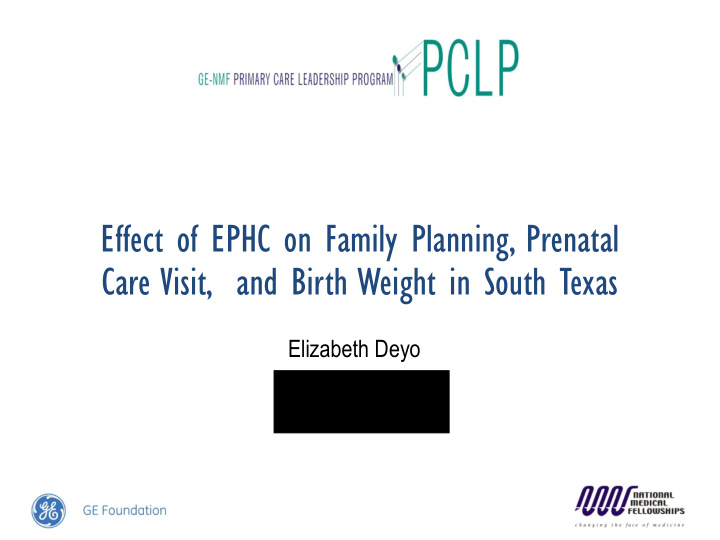



Effect of EPHC on Family Planning, Prenatal Care Visit, and Birth Weight in South Texas Elizabeth Deyo CentroMed San Antonio, TX
Introduction • Expanded Primary Health Care (EPHC) provides insurance to women who previously had no insurance coverage • Electronic Health Records (EHR) from CentroMed used to collect data since EPHC implementation • Early Trends show some impact on family planning and gestational age • Potential for future studies
Background • Experts agree that family planning and contraceptive access should be a major research goal of coming years • Medicaid costs of unplanned pregnancies are 1.3 billion annually in Texas 1 • 2011 funding cuts to women’s health in Texas • EPHC implemented in Nov. 2013 to compensate with these cuts, with several goals including: • Increase the number of women receiving primary and preventive care services • Reduce the number of preterm births 1 Texas Women’s Healthcare in Crisis . Rep. N.p.: n.p., n.d. Texas Women's Healthcare Coalition, 12 Jan. 2013. Web. 31 July 2014 .
Methodology • Data collected for time period EPHC has been implemented, Nov.1, 2013 – Present • Data used for Women aged 18-44, eligible for EPHC • Data extracted directly from EHR system, where it was directly input • Standards from American College of Obstetrics used to determine trimester of gestation at OB intake • Birth Weight ranges used from CDC definitions
Results Family Planning Visits 250 200 Number Of Visits 150 100 50 0 Oct-13 Nov-13 Dec-13 Jan-14 Feb-14 Mar-14 Apr-14 May-14 Month Of Visit
Results
Results
Discussion • Overall trends show increase in family planning visits • Gestational age at intake also shows potential of fewer first OB visits in 2 nd and 3 rd trimesters • Birth weight outcomes showed no clear trend • Likely too early in program implementation to see trends in birth weights • Future research could continue to follow birth weights for those that had first OB visits during EPHC period
Conclusion • Implementation of EPHC is showing impact of family planning visits • Also indications that EPHC is helping women to start prenatal care sooner • Impact on birth weight will have to be studied in the future
Acknowledgements • CentroMed • John Rodriguez, Accountant, Centro Med • Jackie Medrano- Lewis, Director of Women’s Health, CentroMed • OBGYN Department at Centro Med: Dr. Herbert Guzman, Yvette Pineda, and Mary Quintanilla
Recommend
More recommend